Business Finance and Economics Report: Financial Statements and Ratios
VerifiedAdded on 2022/12/09
|12
|3298
|249
Report
AI Summary
This report delves into the core concepts of business finance and economics, examining the micro and macro factors that influence business performance, including customers, suppliers, and economic indicators like interest rates and inflation. It highlights the crucial role of accounting in recording financial transactions, preparing financial statements, and supporting decision-making processes, differentiating between financial and management accounting. The report further explores major financial statements such as the balance sheet, income statement, cash flow statement, and statement of shareholder’s equity, detailing their significance in representing a company's financial health and performance. Additionally, it includes a detailed ratio analysis of XYZ plc for 2019 and 2020, calculating and interpreting key ratios like return on ordinary shareholder’s fund, return on capital employed, and operating profit margin to assess the company's operational efficiency and financial standing. The assignment concludes with an overview of management accounting and its importance in organizational planning, control, and decision-making.

BUSINESS FINANCE AND
ECONOMICS
ECONOMICS
Paraphrase This Document
Need a fresh take? Get an instant paraphrase of this document with our AI Paraphraser
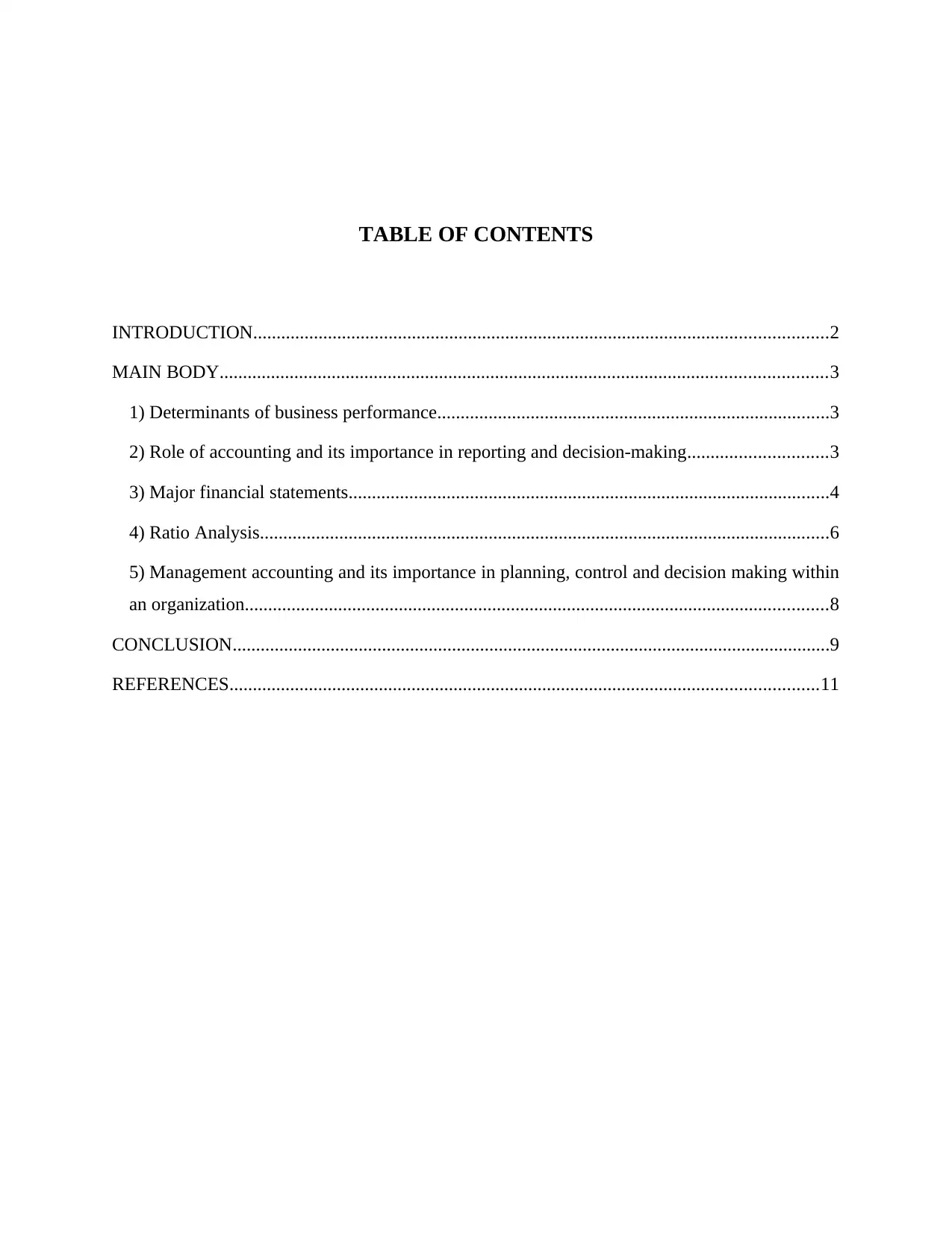
TABLE OF CONTENTS
INTRODUCTION...........................................................................................................................2
MAIN BODY..................................................................................................................................3
1) Determinants of business performance....................................................................................3
2) Role of accounting and its importance in reporting and decision-making..............................3
3) Major financial statements.......................................................................................................4
4) Ratio Analysis..........................................................................................................................6
5) Management accounting and its importance in planning, control and decision making within
an organization.............................................................................................................................8
CONCLUSION................................................................................................................................9
REFERENCES..............................................................................................................................11
INTRODUCTION...........................................................................................................................2
MAIN BODY..................................................................................................................................3
1) Determinants of business performance....................................................................................3
2) Role of accounting and its importance in reporting and decision-making..............................3
3) Major financial statements.......................................................................................................4
4) Ratio Analysis..........................................................................................................................6
5) Management accounting and its importance in planning, control and decision making within
an organization.............................................................................................................................8
CONCLUSION................................................................................................................................9
REFERENCES..............................................................................................................................11
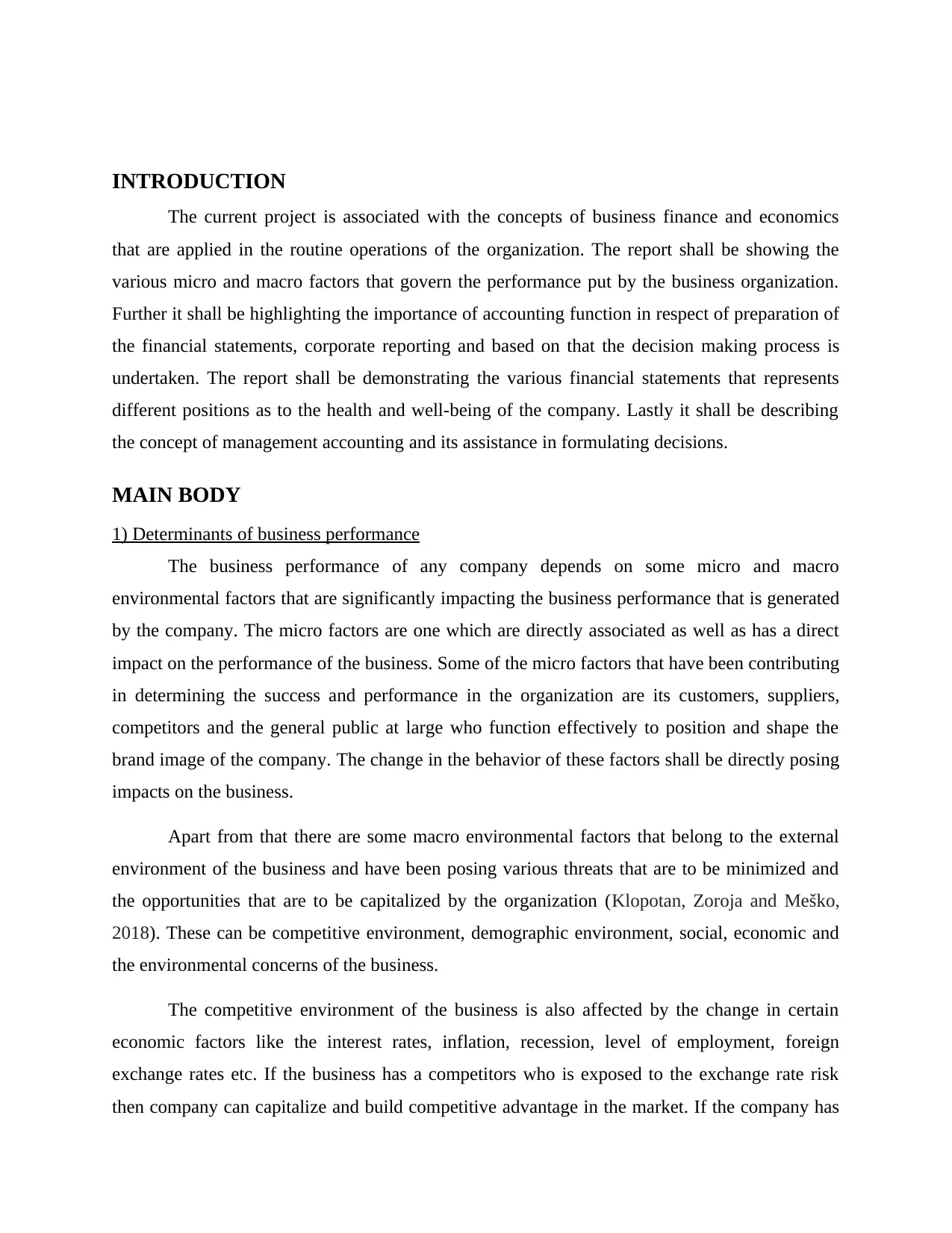
INTRODUCTION
The current project is associated with the concepts of business finance and economics
that are applied in the routine operations of the organization. The report shall be showing the
various micro and macro factors that govern the performance put by the business organization.
Further it shall be highlighting the importance of accounting function in respect of preparation of
the financial statements, corporate reporting and based on that the decision making process is
undertaken. The report shall be demonstrating the various financial statements that represents
different positions as to the health and well-being of the company. Lastly it shall be describing
the concept of management accounting and its assistance in formulating decisions.
MAIN BODY
1) Determinants of business performance
The business performance of any company depends on some micro and macro
environmental factors that are significantly impacting the business performance that is generated
by the company. The micro factors are one which are directly associated as well as has a direct
impact on the performance of the business. Some of the micro factors that have been contributing
in determining the success and performance in the organization are its customers, suppliers,
competitors and the general public at large who function effectively to position and shape the
brand image of the company. The change in the behavior of these factors shall be directly posing
impacts on the business.
Apart from that there are some macro environmental factors that belong to the external
environment of the business and have been posing various threats that are to be minimized and
the opportunities that are to be capitalized by the organization (Klopotan, Zoroja and Meško,
2018). These can be competitive environment, demographic environment, social, economic and
the environmental concerns of the business.
The competitive environment of the business is also affected by the change in certain
economic factors like the interest rates, inflation, recession, level of employment, foreign
exchange rates etc. If the business has a competitors who is exposed to the exchange rate risk
then company can capitalize and build competitive advantage in the market. If the company has
The current project is associated with the concepts of business finance and economics
that are applied in the routine operations of the organization. The report shall be showing the
various micro and macro factors that govern the performance put by the business organization.
Further it shall be highlighting the importance of accounting function in respect of preparation of
the financial statements, corporate reporting and based on that the decision making process is
undertaken. The report shall be demonstrating the various financial statements that represents
different positions as to the health and well-being of the company. Lastly it shall be describing
the concept of management accounting and its assistance in formulating decisions.
MAIN BODY
1) Determinants of business performance
The business performance of any company depends on some micro and macro
environmental factors that are significantly impacting the business performance that is generated
by the company. The micro factors are one which are directly associated as well as has a direct
impact on the performance of the business. Some of the micro factors that have been contributing
in determining the success and performance in the organization are its customers, suppliers,
competitors and the general public at large who function effectively to position and shape the
brand image of the company. The change in the behavior of these factors shall be directly posing
impacts on the business.
Apart from that there are some macro environmental factors that belong to the external
environment of the business and have been posing various threats that are to be minimized and
the opportunities that are to be capitalized by the organization (Klopotan, Zoroja and Meško,
2018). These can be competitive environment, demographic environment, social, economic and
the environmental concerns of the business.
The competitive environment of the business is also affected by the change in certain
economic factors like the interest rates, inflation, recession, level of employment, foreign
exchange rates etc. If the business has a competitors who is exposed to the exchange rate risk
then company can capitalize and build competitive advantage in the market. If the company has
⊘ This is a preview!⊘
Do you want full access?
Subscribe today to unlock all pages.

Trusted by 1+ million students worldwide
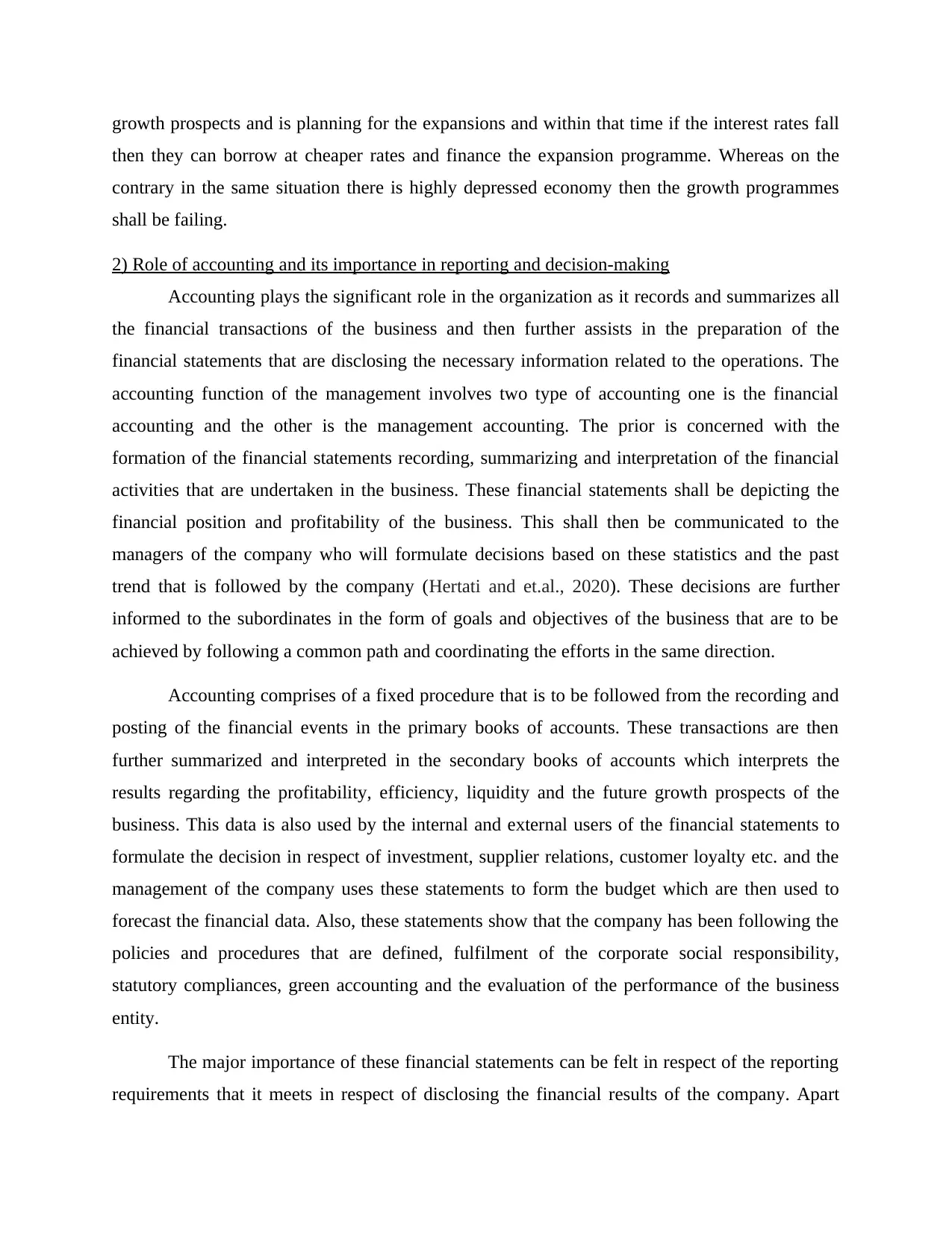
growth prospects and is planning for the expansions and within that time if the interest rates fall
then they can borrow at cheaper rates and finance the expansion programme. Whereas on the
contrary in the same situation there is highly depressed economy then the growth programmes
shall be failing.
2) Role of accounting and its importance in reporting and decision-making
Accounting plays the significant role in the organization as it records and summarizes all
the financial transactions of the business and then further assists in the preparation of the
financial statements that are disclosing the necessary information related to the operations. The
accounting function of the management involves two type of accounting one is the financial
accounting and the other is the management accounting. The prior is concerned with the
formation of the financial statements recording, summarizing and interpretation of the financial
activities that are undertaken in the business. These financial statements shall be depicting the
financial position and profitability of the business. This shall then be communicated to the
managers of the company who will formulate decisions based on these statistics and the past
trend that is followed by the company (Hertati and et.al., 2020). These decisions are further
informed to the subordinates in the form of goals and objectives of the business that are to be
achieved by following a common path and coordinating the efforts in the same direction.
Accounting comprises of a fixed procedure that is to be followed from the recording and
posting of the financial events in the primary books of accounts. These transactions are then
further summarized and interpreted in the secondary books of accounts which interprets the
results regarding the profitability, efficiency, liquidity and the future growth prospects of the
business. This data is also used by the internal and external users of the financial statements to
formulate the decision in respect of investment, supplier relations, customer loyalty etc. and the
management of the company uses these statements to form the budget which are then used to
forecast the financial data. Also, these statements show that the company has been following the
policies and procedures that are defined, fulfilment of the corporate social responsibility,
statutory compliances, green accounting and the evaluation of the performance of the business
entity.
The major importance of these financial statements can be felt in respect of the reporting
requirements that it meets in respect of disclosing the financial results of the company. Apart
then they can borrow at cheaper rates and finance the expansion programme. Whereas on the
contrary in the same situation there is highly depressed economy then the growth programmes
shall be failing.
2) Role of accounting and its importance in reporting and decision-making
Accounting plays the significant role in the organization as it records and summarizes all
the financial transactions of the business and then further assists in the preparation of the
financial statements that are disclosing the necessary information related to the operations. The
accounting function of the management involves two type of accounting one is the financial
accounting and the other is the management accounting. The prior is concerned with the
formation of the financial statements recording, summarizing and interpretation of the financial
activities that are undertaken in the business. These financial statements shall be depicting the
financial position and profitability of the business. This shall then be communicated to the
managers of the company who will formulate decisions based on these statistics and the past
trend that is followed by the company (Hertati and et.al., 2020). These decisions are further
informed to the subordinates in the form of goals and objectives of the business that are to be
achieved by following a common path and coordinating the efforts in the same direction.
Accounting comprises of a fixed procedure that is to be followed from the recording and
posting of the financial events in the primary books of accounts. These transactions are then
further summarized and interpreted in the secondary books of accounts which interprets the
results regarding the profitability, efficiency, liquidity and the future growth prospects of the
business. This data is also used by the internal and external users of the financial statements to
formulate the decision in respect of investment, supplier relations, customer loyalty etc. and the
management of the company uses these statements to form the budget which are then used to
forecast the financial data. Also, these statements show that the company has been following the
policies and procedures that are defined, fulfilment of the corporate social responsibility,
statutory compliances, green accounting and the evaluation of the performance of the business
entity.
The major importance of these financial statements can be felt in respect of the reporting
requirements that it meets in respect of disclosing the financial results of the company. Apart
Paraphrase This Document
Need a fresh take? Get an instant paraphrase of this document with our AI Paraphraser
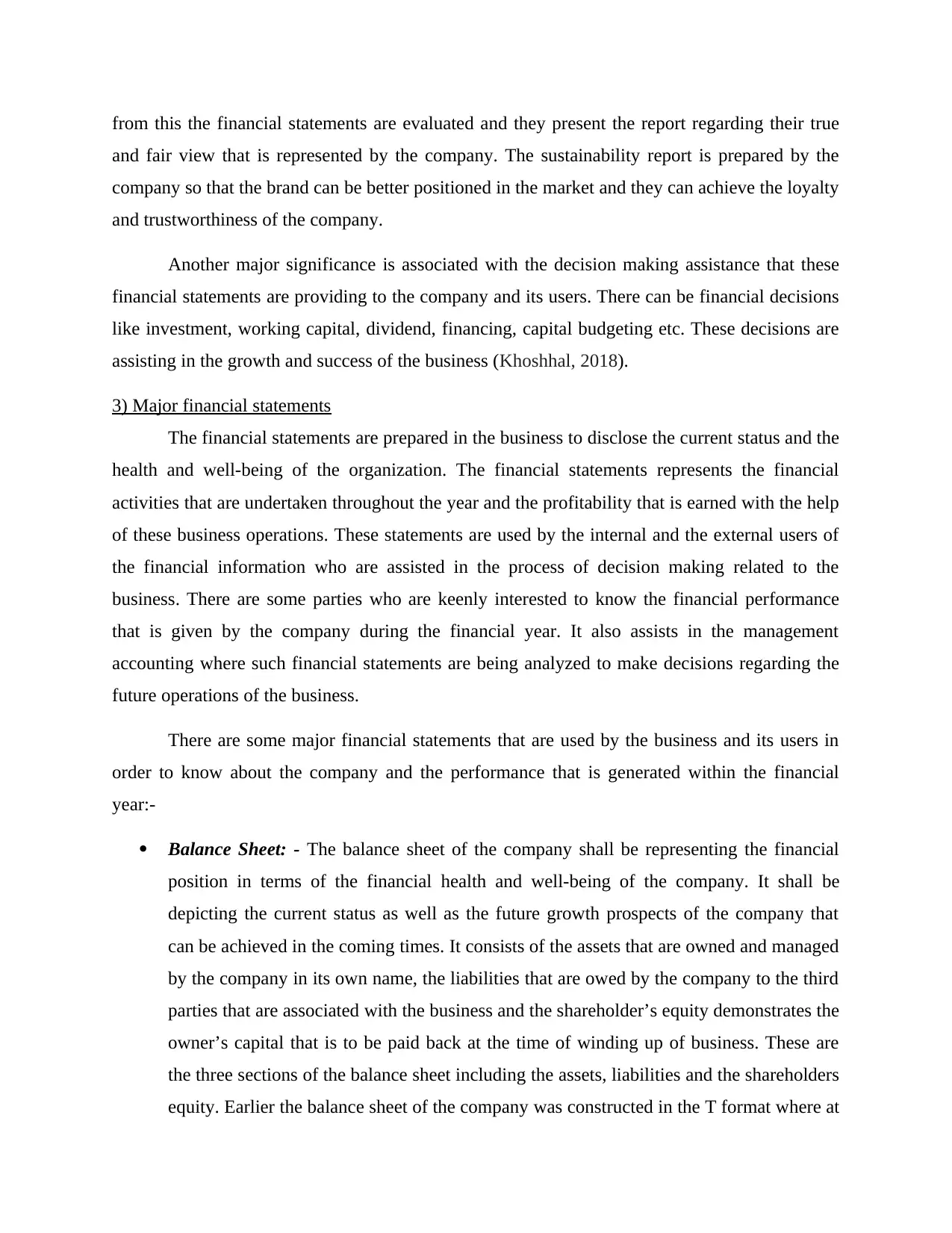
from this the financial statements are evaluated and they present the report regarding their true
and fair view that is represented by the company. The sustainability report is prepared by the
company so that the brand can be better positioned in the market and they can achieve the loyalty
and trustworthiness of the company.
Another major significance is associated with the decision making assistance that these
financial statements are providing to the company and its users. There can be financial decisions
like investment, working capital, dividend, financing, capital budgeting etc. These decisions are
assisting in the growth and success of the business (Khoshhal, 2018).
3) Major financial statements
The financial statements are prepared in the business to disclose the current status and the
health and well-being of the organization. The financial statements represents the financial
activities that are undertaken throughout the year and the profitability that is earned with the help
of these business operations. These statements are used by the internal and the external users of
the financial information who are assisted in the process of decision making related to the
business. There are some parties who are keenly interested to know the financial performance
that is given by the company during the financial year. It also assists in the management
accounting where such financial statements are being analyzed to make decisions regarding the
future operations of the business.
There are some major financial statements that are used by the business and its users in
order to know about the company and the performance that is generated within the financial
year:-
Balance Sheet: - The balance sheet of the company shall be representing the financial
position in terms of the financial health and well-being of the company. It shall be
depicting the current status as well as the future growth prospects of the company that
can be achieved in the coming times. It consists of the assets that are owned and managed
by the company in its own name, the liabilities that are owed by the company to the third
parties that are associated with the business and the shareholder’s equity demonstrates the
owner’s capital that is to be paid back at the time of winding up of business. These are
the three sections of the balance sheet including the assets, liabilities and the shareholders
equity. Earlier the balance sheet of the company was constructed in the T format where at
and fair view that is represented by the company. The sustainability report is prepared by the
company so that the brand can be better positioned in the market and they can achieve the loyalty
and trustworthiness of the company.
Another major significance is associated with the decision making assistance that these
financial statements are providing to the company and its users. There can be financial decisions
like investment, working capital, dividend, financing, capital budgeting etc. These decisions are
assisting in the growth and success of the business (Khoshhal, 2018).
3) Major financial statements
The financial statements are prepared in the business to disclose the current status and the
health and well-being of the organization. The financial statements represents the financial
activities that are undertaken throughout the year and the profitability that is earned with the help
of these business operations. These statements are used by the internal and the external users of
the financial information who are assisted in the process of decision making related to the
business. There are some parties who are keenly interested to know the financial performance
that is given by the company during the financial year. It also assists in the management
accounting where such financial statements are being analyzed to make decisions regarding the
future operations of the business.
There are some major financial statements that are used by the business and its users in
order to know about the company and the performance that is generated within the financial
year:-
Balance Sheet: - The balance sheet of the company shall be representing the financial
position in terms of the financial health and well-being of the company. It shall be
depicting the current status as well as the future growth prospects of the company that
can be achieved in the coming times. It consists of the assets that are owned and managed
by the company in its own name, the liabilities that are owed by the company to the third
parties that are associated with the business and the shareholder’s equity demonstrates the
owner’s capital that is to be paid back at the time of winding up of business. These are
the three sections of the balance sheet including the assets, liabilities and the shareholders
equity. Earlier the balance sheet of the company was constructed in the T format where at
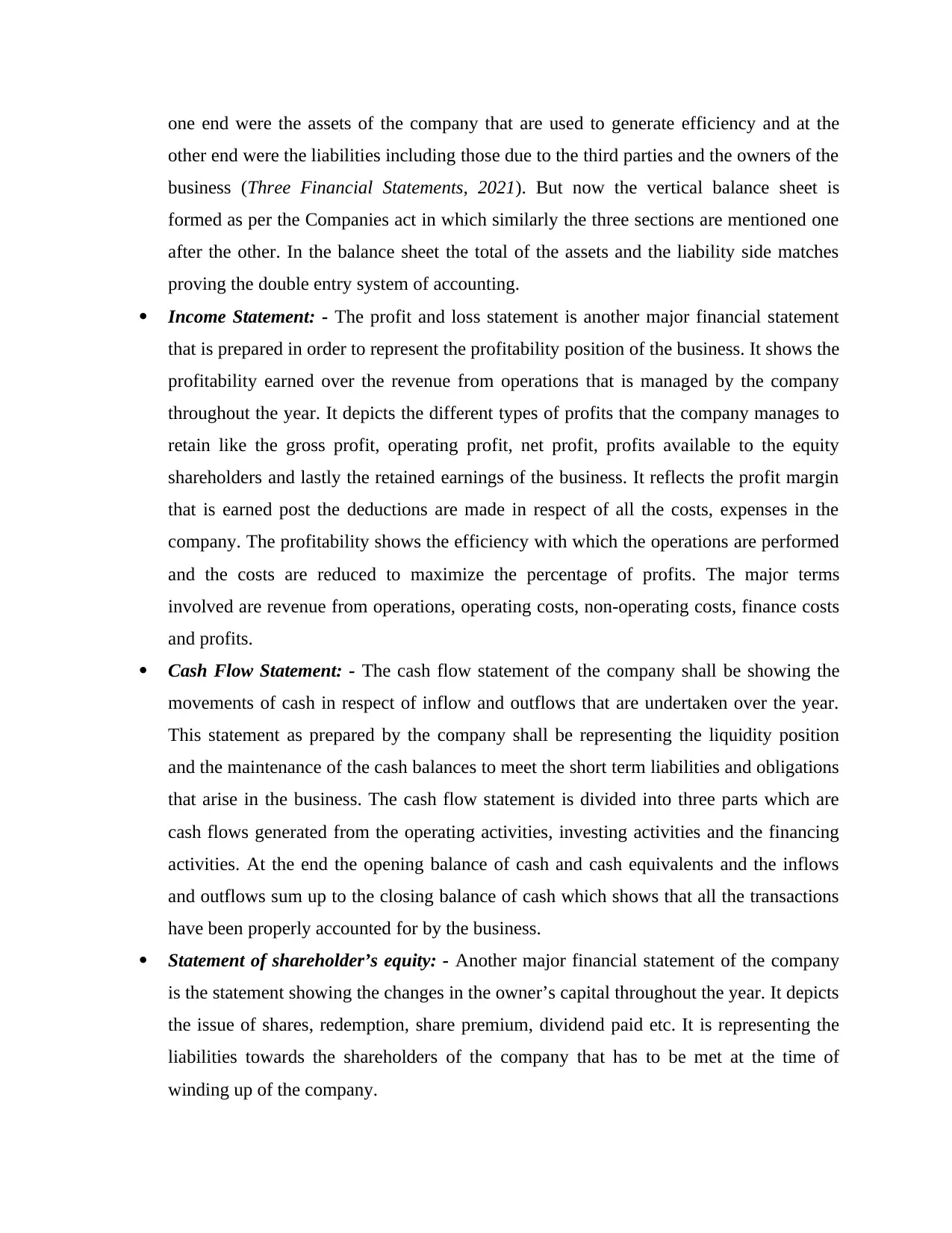
one end were the assets of the company that are used to generate efficiency and at the
other end were the liabilities including those due to the third parties and the owners of the
business (Three Financial Statements, 2021). But now the vertical balance sheet is
formed as per the Companies act in which similarly the three sections are mentioned one
after the other. In the balance sheet the total of the assets and the liability side matches
proving the double entry system of accounting.
Income Statement: - The profit and loss statement is another major financial statement
that is prepared in order to represent the profitability position of the business. It shows the
profitability earned over the revenue from operations that is managed by the company
throughout the year. It depicts the different types of profits that the company manages to
retain like the gross profit, operating profit, net profit, profits available to the equity
shareholders and lastly the retained earnings of the business. It reflects the profit margin
that is earned post the deductions are made in respect of all the costs, expenses in the
company. The profitability shows the efficiency with which the operations are performed
and the costs are reduced to maximize the percentage of profits. The major terms
involved are revenue from operations, operating costs, non-operating costs, finance costs
and profits.
Cash Flow Statement: - The cash flow statement of the company shall be showing the
movements of cash in respect of inflow and outflows that are undertaken over the year.
This statement as prepared by the company shall be representing the liquidity position
and the maintenance of the cash balances to meet the short term liabilities and obligations
that arise in the business. The cash flow statement is divided into three parts which are
cash flows generated from the operating activities, investing activities and the financing
activities. At the end the opening balance of cash and cash equivalents and the inflows
and outflows sum up to the closing balance of cash which shows that all the transactions
have been properly accounted for by the business.
Statement of shareholder’s equity: - Another major financial statement of the company
is the statement showing the changes in the owner’s capital throughout the year. It depicts
the issue of shares, redemption, share premium, dividend paid etc. It is representing the
liabilities towards the shareholders of the company that has to be met at the time of
winding up of the company.
other end were the liabilities including those due to the third parties and the owners of the
business (Three Financial Statements, 2021). But now the vertical balance sheet is
formed as per the Companies act in which similarly the three sections are mentioned one
after the other. In the balance sheet the total of the assets and the liability side matches
proving the double entry system of accounting.
Income Statement: - The profit and loss statement is another major financial statement
that is prepared in order to represent the profitability position of the business. It shows the
profitability earned over the revenue from operations that is managed by the company
throughout the year. It depicts the different types of profits that the company manages to
retain like the gross profit, operating profit, net profit, profits available to the equity
shareholders and lastly the retained earnings of the business. It reflects the profit margin
that is earned post the deductions are made in respect of all the costs, expenses in the
company. The profitability shows the efficiency with which the operations are performed
and the costs are reduced to maximize the percentage of profits. The major terms
involved are revenue from operations, operating costs, non-operating costs, finance costs
and profits.
Cash Flow Statement: - The cash flow statement of the company shall be showing the
movements of cash in respect of inflow and outflows that are undertaken over the year.
This statement as prepared by the company shall be representing the liquidity position
and the maintenance of the cash balances to meet the short term liabilities and obligations
that arise in the business. The cash flow statement is divided into three parts which are
cash flows generated from the operating activities, investing activities and the financing
activities. At the end the opening balance of cash and cash equivalents and the inflows
and outflows sum up to the closing balance of cash which shows that all the transactions
have been properly accounted for by the business.
Statement of shareholder’s equity: - Another major financial statement of the company
is the statement showing the changes in the owner’s capital throughout the year. It depicts
the issue of shares, redemption, share premium, dividend paid etc. It is representing the
liabilities towards the shareholders of the company that has to be met at the time of
winding up of the company.
⊘ This is a preview!⊘
Do you want full access?
Subscribe today to unlock all pages.

Trusted by 1+ million students worldwide
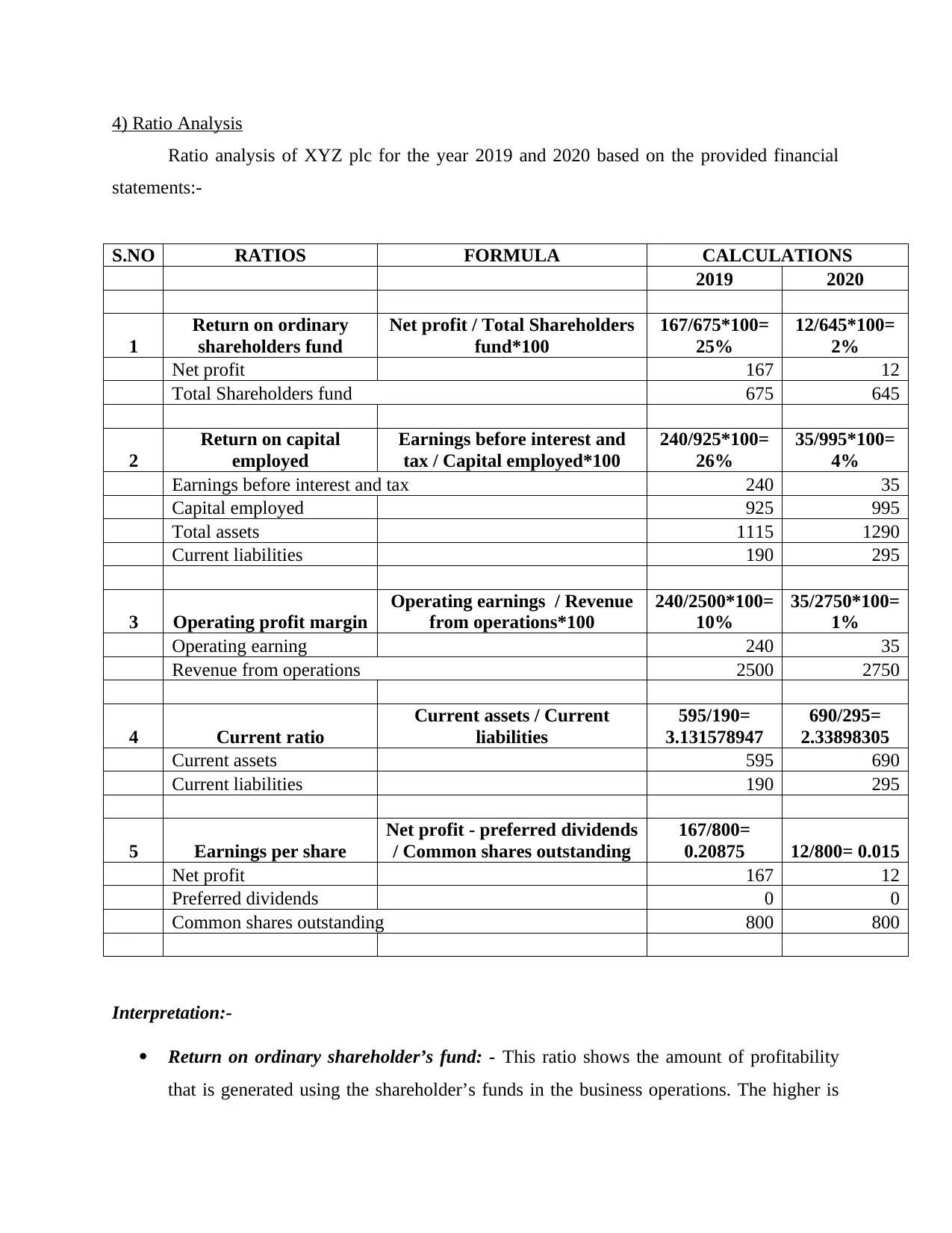
4) Ratio Analysis
Ratio analysis of XYZ plc for the year 2019 and 2020 based on the provided financial
statements:-
S.NO RATIOS FORMULA CALCULATIONS
2019 2020
1
Return on ordinary
shareholders fund
Net profit / Total Shareholders
fund*100
167/675*100=
25%
12/645*100=
2%
Net profit 167 12
Total Shareholders fund 675 645
2
Return on capital
employed
Earnings before interest and
tax / Capital employed*100
240/925*100=
26%
35/995*100=
4%
Earnings before interest and tax 240 35
Capital employed 925 995
Total assets 1115 1290
Current liabilities 190 295
3 Operating profit margin
Operating earnings / Revenue
from operations*100
240/2500*100=
10%
35/2750*100=
1%
Operating earning 240 35
Revenue from operations 2500 2750
4 Current ratio
Current assets / Current
liabilities
595/190=
3.131578947
690/295=
2.33898305
Current assets 595 690
Current liabilities 190 295
5 Earnings per share
Net profit - preferred dividends
/ Common shares outstanding
167/800=
0.20875 12/800= 0.015
Net profit 167 12
Preferred dividends 0 0
Common shares outstanding 800 800
Interpretation:-
Return on ordinary shareholder’s fund: - This ratio shows the amount of profitability
that is generated using the shareholder’s funds in the business operations. The higher is
Ratio analysis of XYZ plc for the year 2019 and 2020 based on the provided financial
statements:-
S.NO RATIOS FORMULA CALCULATIONS
2019 2020
1
Return on ordinary
shareholders fund
Net profit / Total Shareholders
fund*100
167/675*100=
25%
12/645*100=
2%
Net profit 167 12
Total Shareholders fund 675 645
2
Return on capital
employed
Earnings before interest and
tax / Capital employed*100
240/925*100=
26%
35/995*100=
4%
Earnings before interest and tax 240 35
Capital employed 925 995
Total assets 1115 1290
Current liabilities 190 295
3 Operating profit margin
Operating earnings / Revenue
from operations*100
240/2500*100=
10%
35/2750*100=
1%
Operating earning 240 35
Revenue from operations 2500 2750
4 Current ratio
Current assets / Current
liabilities
595/190=
3.131578947
690/295=
2.33898305
Current assets 595 690
Current liabilities 190 295
5 Earnings per share
Net profit - preferred dividends
/ Common shares outstanding
167/800=
0.20875 12/800= 0.015
Net profit 167 12
Preferred dividends 0 0
Common shares outstanding 800 800
Interpretation:-
Return on ordinary shareholder’s fund: - This ratio shows the amount of profitability
that is generated using the shareholder’s funds in the business operations. The higher is
Paraphrase This Document
Need a fresh take? Get an instant paraphrase of this document with our AI Paraphraser
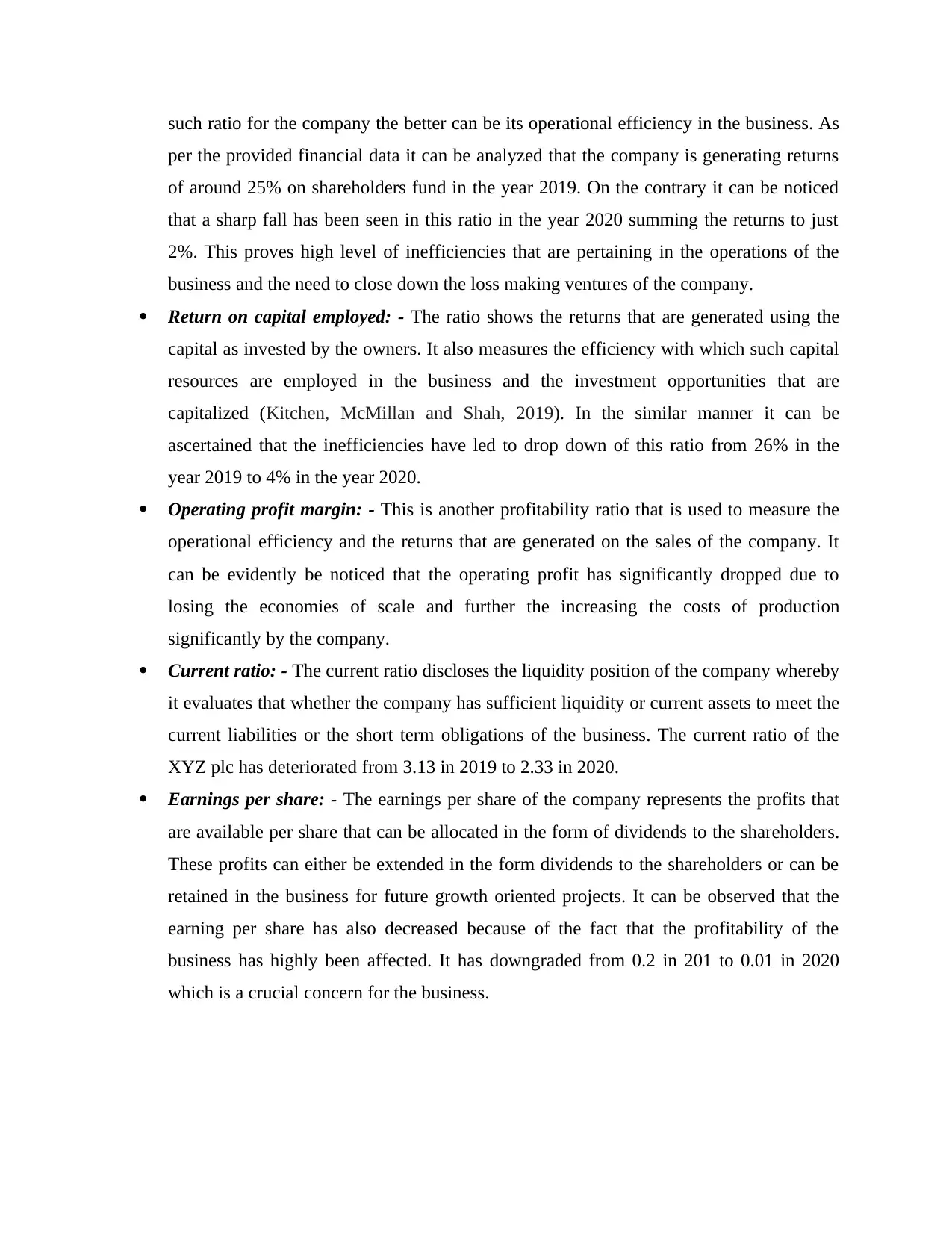
such ratio for the company the better can be its operational efficiency in the business. As
per the provided financial data it can be analyzed that the company is generating returns
of around 25% on shareholders fund in the year 2019. On the contrary it can be noticed
that a sharp fall has been seen in this ratio in the year 2020 summing the returns to just
2%. This proves high level of inefficiencies that are pertaining in the operations of the
business and the need to close down the loss making ventures of the company.
Return on capital employed: - The ratio shows the returns that are generated using the
capital as invested by the owners. It also measures the efficiency with which such capital
resources are employed in the business and the investment opportunities that are
capitalized (Kitchen, McMillan and Shah, 2019). In the similar manner it can be
ascertained that the inefficiencies have led to drop down of this ratio from 26% in the
year 2019 to 4% in the year 2020.
Operating profit margin: - This is another profitability ratio that is used to measure the
operational efficiency and the returns that are generated on the sales of the company. It
can be evidently be noticed that the operating profit has significantly dropped due to
losing the economies of scale and further the increasing the costs of production
significantly by the company.
Current ratio: - The current ratio discloses the liquidity position of the company whereby
it evaluates that whether the company has sufficient liquidity or current assets to meet the
current liabilities or the short term obligations of the business. The current ratio of the
XYZ plc has deteriorated from 3.13 in 2019 to 2.33 in 2020.
Earnings per share: - The earnings per share of the company represents the profits that
are available per share that can be allocated in the form of dividends to the shareholders.
These profits can either be extended in the form dividends to the shareholders or can be
retained in the business for future growth oriented projects. It can be observed that the
earning per share has also decreased because of the fact that the profitability of the
business has highly been affected. It has downgraded from 0.2 in 201 to 0.01 in 2020
which is a crucial concern for the business.
per the provided financial data it can be analyzed that the company is generating returns
of around 25% on shareholders fund in the year 2019. On the contrary it can be noticed
that a sharp fall has been seen in this ratio in the year 2020 summing the returns to just
2%. This proves high level of inefficiencies that are pertaining in the operations of the
business and the need to close down the loss making ventures of the company.
Return on capital employed: - The ratio shows the returns that are generated using the
capital as invested by the owners. It also measures the efficiency with which such capital
resources are employed in the business and the investment opportunities that are
capitalized (Kitchen, McMillan and Shah, 2019). In the similar manner it can be
ascertained that the inefficiencies have led to drop down of this ratio from 26% in the
year 2019 to 4% in the year 2020.
Operating profit margin: - This is another profitability ratio that is used to measure the
operational efficiency and the returns that are generated on the sales of the company. It
can be evidently be noticed that the operating profit has significantly dropped due to
losing the economies of scale and further the increasing the costs of production
significantly by the company.
Current ratio: - The current ratio discloses the liquidity position of the company whereby
it evaluates that whether the company has sufficient liquidity or current assets to meet the
current liabilities or the short term obligations of the business. The current ratio of the
XYZ plc has deteriorated from 3.13 in 2019 to 2.33 in 2020.
Earnings per share: - The earnings per share of the company represents the profits that
are available per share that can be allocated in the form of dividends to the shareholders.
These profits can either be extended in the form dividends to the shareholders or can be
retained in the business for future growth oriented projects. It can be observed that the
earning per share has also decreased because of the fact that the profitability of the
business has highly been affected. It has downgraded from 0.2 in 201 to 0.01 in 2020
which is a crucial concern for the business.
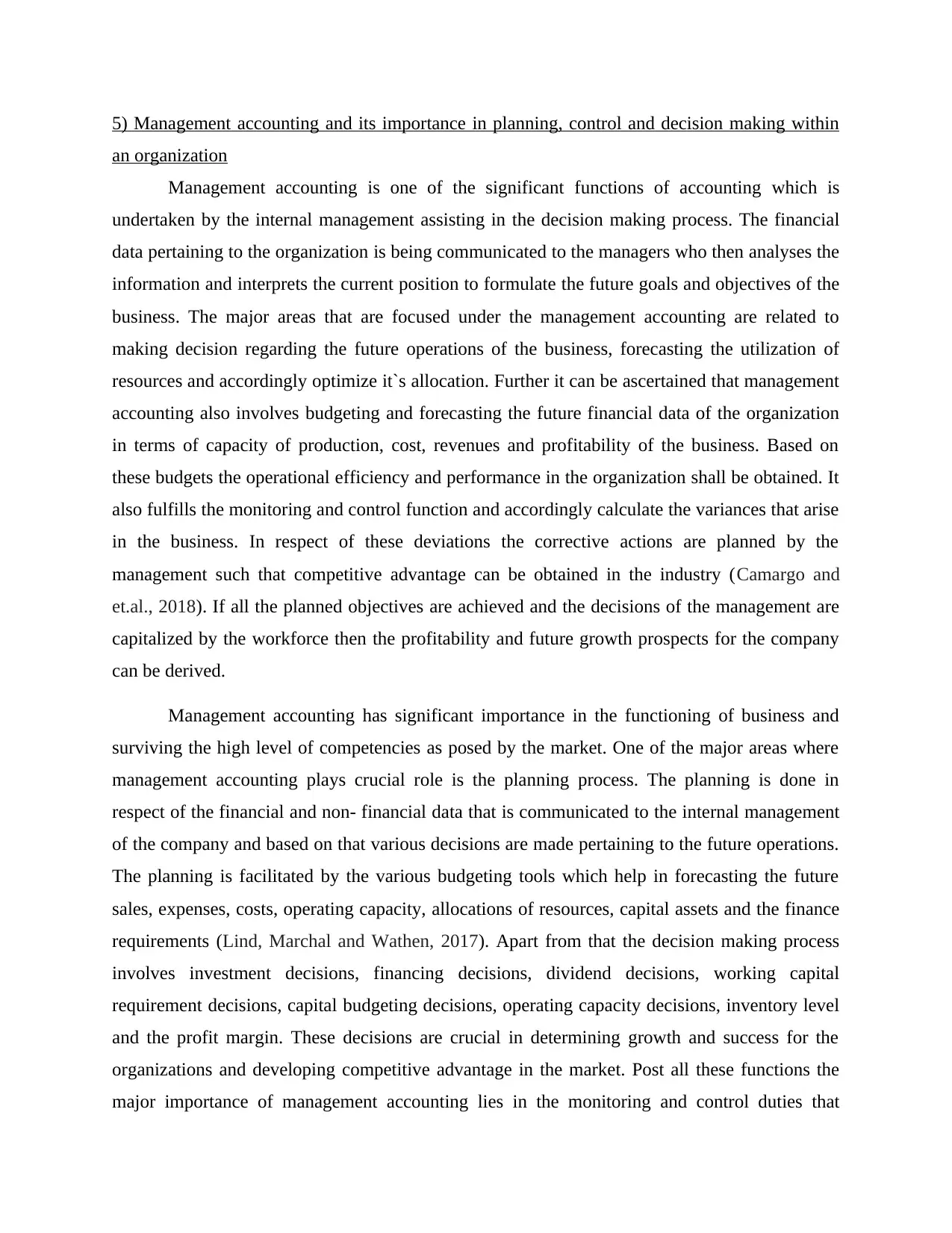
5) Management accounting and its importance in planning, control and decision making within
an organization
Management accounting is one of the significant functions of accounting which is
undertaken by the internal management assisting in the decision making process. The financial
data pertaining to the organization is being communicated to the managers who then analyses the
information and interprets the current position to formulate the future goals and objectives of the
business. The major areas that are focused under the management accounting are related to
making decision regarding the future operations of the business, forecasting the utilization of
resources and accordingly optimize it`s allocation. Further it can be ascertained that management
accounting also involves budgeting and forecasting the future financial data of the organization
in terms of capacity of production, cost, revenues and profitability of the business. Based on
these budgets the operational efficiency and performance in the organization shall be obtained. It
also fulfills the monitoring and control function and accordingly calculate the variances that arise
in the business. In respect of these deviations the corrective actions are planned by the
management such that competitive advantage can be obtained in the industry (Camargo and
et.al., 2018). If all the planned objectives are achieved and the decisions of the management are
capitalized by the workforce then the profitability and future growth prospects for the company
can be derived.
Management accounting has significant importance in the functioning of business and
surviving the high level of competencies as posed by the market. One of the major areas where
management accounting plays crucial role is the planning process. The planning is done in
respect of the financial and non- financial data that is communicated to the internal management
of the company and based on that various decisions are made pertaining to the future operations.
The planning is facilitated by the various budgeting tools which help in forecasting the future
sales, expenses, costs, operating capacity, allocations of resources, capital assets and the finance
requirements (Lind, Marchal and Wathen, 2017). Apart from that the decision making process
involves investment decisions, financing decisions, dividend decisions, working capital
requirement decisions, capital budgeting decisions, operating capacity decisions, inventory level
and the profit margin. These decisions are crucial in determining growth and success for the
organizations and developing competitive advantage in the market. Post all these functions the
major importance of management accounting lies in the monitoring and control duties that
an organization
Management accounting is one of the significant functions of accounting which is
undertaken by the internal management assisting in the decision making process. The financial
data pertaining to the organization is being communicated to the managers who then analyses the
information and interprets the current position to formulate the future goals and objectives of the
business. The major areas that are focused under the management accounting are related to
making decision regarding the future operations of the business, forecasting the utilization of
resources and accordingly optimize it`s allocation. Further it can be ascertained that management
accounting also involves budgeting and forecasting the future financial data of the organization
in terms of capacity of production, cost, revenues and profitability of the business. Based on
these budgets the operational efficiency and performance in the organization shall be obtained. It
also fulfills the monitoring and control function and accordingly calculate the variances that arise
in the business. In respect of these deviations the corrective actions are planned by the
management such that competitive advantage can be obtained in the industry (Camargo and
et.al., 2018). If all the planned objectives are achieved and the decisions of the management are
capitalized by the workforce then the profitability and future growth prospects for the company
can be derived.
Management accounting has significant importance in the functioning of business and
surviving the high level of competencies as posed by the market. One of the major areas where
management accounting plays crucial role is the planning process. The planning is done in
respect of the financial and non- financial data that is communicated to the internal management
of the company and based on that various decisions are made pertaining to the future operations.
The planning is facilitated by the various budgeting tools which help in forecasting the future
sales, expenses, costs, operating capacity, allocations of resources, capital assets and the finance
requirements (Lind, Marchal and Wathen, 2017). Apart from that the decision making process
involves investment decisions, financing decisions, dividend decisions, working capital
requirement decisions, capital budgeting decisions, operating capacity decisions, inventory level
and the profit margin. These decisions are crucial in determining growth and success for the
organizations and developing competitive advantage in the market. Post all these functions the
major importance of management accounting lies in the monitoring and control duties that
⊘ This is a preview!⊘
Do you want full access?
Subscribe today to unlock all pages.

Trusted by 1+ million students worldwide
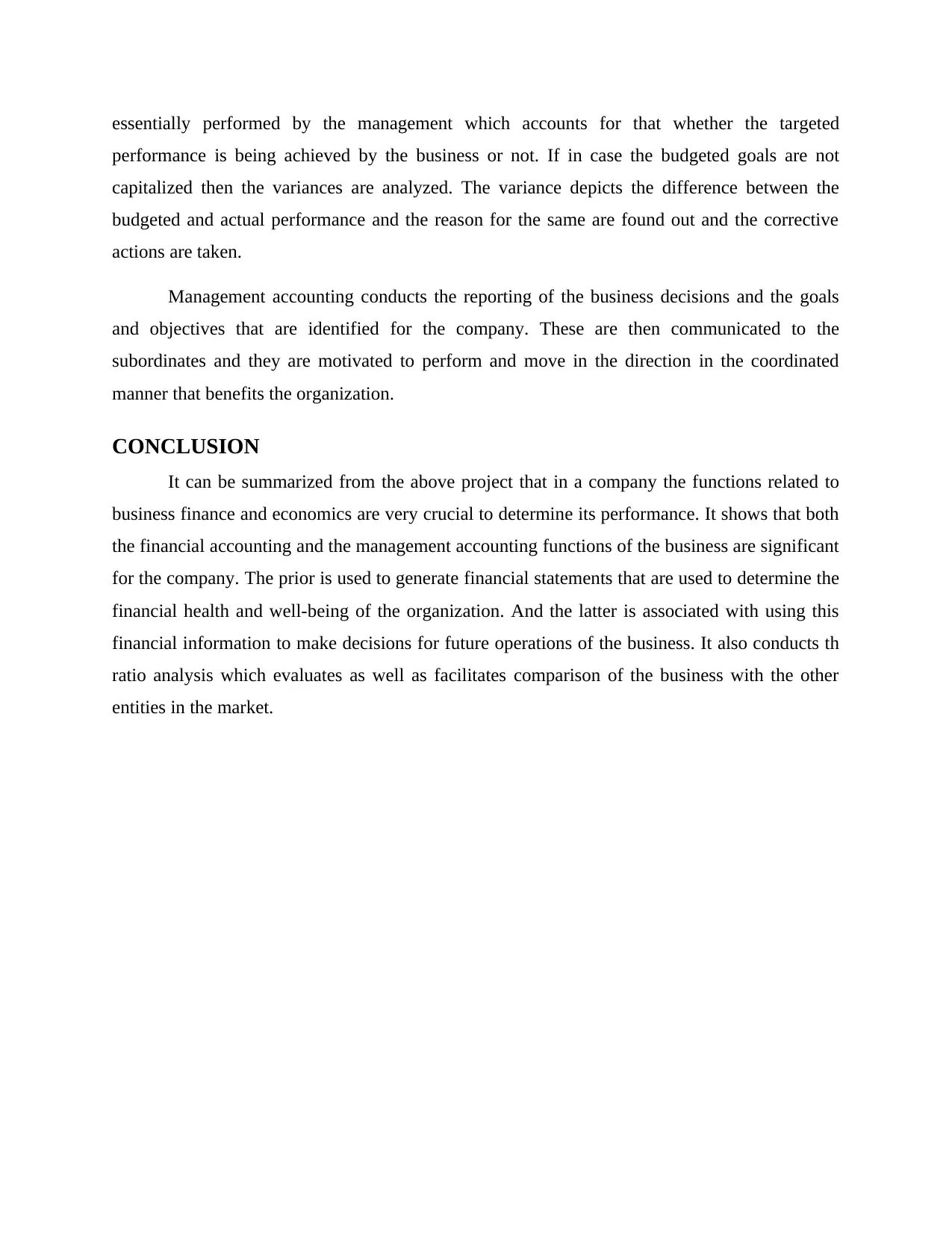
essentially performed by the management which accounts for that whether the targeted
performance is being achieved by the business or not. If in case the budgeted goals are not
capitalized then the variances are analyzed. The variance depicts the difference between the
budgeted and actual performance and the reason for the same are found out and the corrective
actions are taken.
Management accounting conducts the reporting of the business decisions and the goals
and objectives that are identified for the company. These are then communicated to the
subordinates and they are motivated to perform and move in the direction in the coordinated
manner that benefits the organization.
CONCLUSION
It can be summarized from the above project that in a company the functions related to
business finance and economics are very crucial to determine its performance. It shows that both
the financial accounting and the management accounting functions of the business are significant
for the company. The prior is used to generate financial statements that are used to determine the
financial health and well-being of the organization. And the latter is associated with using this
financial information to make decisions for future operations of the business. It also conducts th
ratio analysis which evaluates as well as facilitates comparison of the business with the other
entities in the market.
performance is being achieved by the business or not. If in case the budgeted goals are not
capitalized then the variances are analyzed. The variance depicts the difference between the
budgeted and actual performance and the reason for the same are found out and the corrective
actions are taken.
Management accounting conducts the reporting of the business decisions and the goals
and objectives that are identified for the company. These are then communicated to the
subordinates and they are motivated to perform and move in the direction in the coordinated
manner that benefits the organization.
CONCLUSION
It can be summarized from the above project that in a company the functions related to
business finance and economics are very crucial to determine its performance. It shows that both
the financial accounting and the management accounting functions of the business are significant
for the company. The prior is used to generate financial statements that are used to determine the
financial health and well-being of the organization. And the latter is associated with using this
financial information to make decisions for future operations of the business. It also conducts th
ratio analysis which evaluates as well as facilitates comparison of the business with the other
entities in the market.
Paraphrase This Document
Need a fresh take? Get an instant paraphrase of this document with our AI Paraphraser
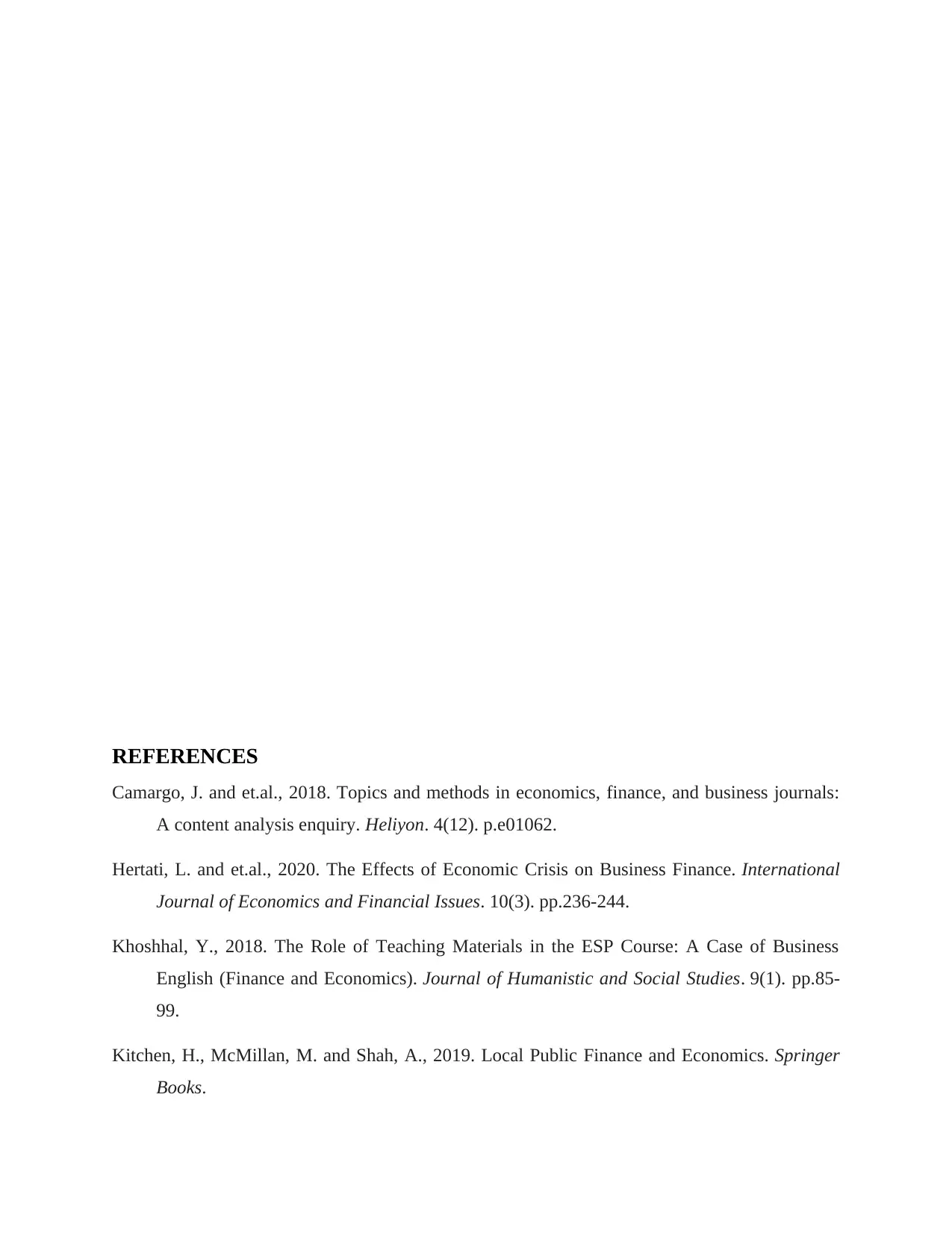
REFERENCES
Camargo, J. and et.al., 2018. Topics and methods in economics, finance, and business journals:
A content analysis enquiry. Heliyon. 4(12). p.e01062.
Hertati, L. and et.al., 2020. The Effects of Economic Crisis on Business Finance. International
Journal of Economics and Financial Issues. 10(3). pp.236-244.
Khoshhal, Y., 2018. The Role of Teaching Materials in the ESP Course: A Case of Business
English (Finance and Economics). Journal of Humanistic and Social Studies. 9(1). pp.85-
99.
Kitchen, H., McMillan, M. and Shah, A., 2019. Local Public Finance and Economics. Springer
Books.
Camargo, J. and et.al., 2018. Topics and methods in economics, finance, and business journals:
A content analysis enquiry. Heliyon. 4(12). p.e01062.
Hertati, L. and et.al., 2020. The Effects of Economic Crisis on Business Finance. International
Journal of Economics and Financial Issues. 10(3). pp.236-244.
Khoshhal, Y., 2018. The Role of Teaching Materials in the ESP Course: A Case of Business
English (Finance and Economics). Journal of Humanistic and Social Studies. 9(1). pp.85-
99.
Kitchen, H., McMillan, M. and Shah, A., 2019. Local Public Finance and Economics. Springer
Books.
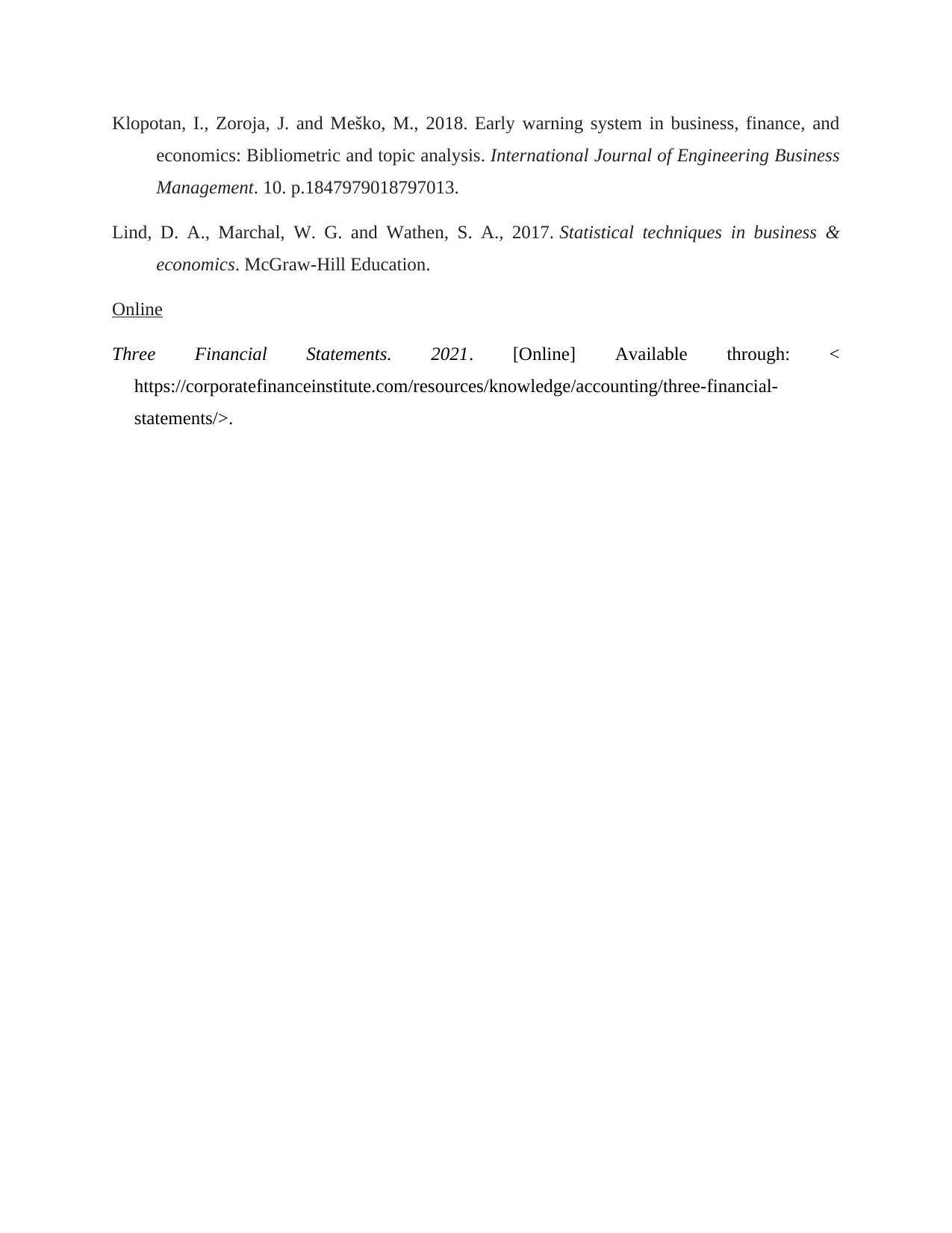
Klopotan, I., Zoroja, J. and Meško, M., 2018. Early warning system in business, finance, and
economics: Bibliometric and topic analysis. International Journal of Engineering Business
Management. 10. p.1847979018797013.
Lind, D. A., Marchal, W. G. and Wathen, S. A., 2017. Statistical techniques in business &
economics. McGraw-Hill Education.
Online
Three Financial Statements. 2021. [Online] Available through: <
https://corporatefinanceinstitute.com/resources/knowledge/accounting/three-financial-
statements/>.
economics: Bibliometric and topic analysis. International Journal of Engineering Business
Management. 10. p.1847979018797013.
Lind, D. A., Marchal, W. G. and Wathen, S. A., 2017. Statistical techniques in business &
economics. McGraw-Hill Education.
Online
Three Financial Statements. 2021. [Online] Available through: <
https://corporatefinanceinstitute.com/resources/knowledge/accounting/three-financial-
statements/>.
⊘ This is a preview!⊘
Do you want full access?
Subscribe today to unlock all pages.

Trusted by 1+ million students worldwide
1 out of 12
Related Documents
Your All-in-One AI-Powered Toolkit for Academic Success.
+13062052269
info@desklib.com
Available 24*7 on WhatsApp / Email
![[object Object]](/_next/static/media/star-bottom.7253800d.svg)
Unlock your academic potential
Copyright © 2020–2025 A2Z Services. All Rights Reserved. Developed and managed by ZUCOL.




